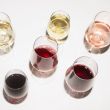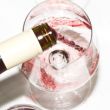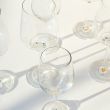If only looking at a wine list were as easy as answering the perennial dinner party question “Red or white?” Unfortunately, it's rarely that simple. Achieving any sort of mastery in wine tasting takes practice (and by practice, we mean drinking). To get the ball rolling, here's a simple guide to what's what, penned by Jordan Salcito, the beverage director at Momofuku. Might take some studying, but boozy studying is fun studying. Cheers!
My dad’s dad used to make terrible wine in his basement in Waterbury, Connecticut. I never met my grandfather or tasted his homemade booze, but making wine with his father is one of my dad’s favorite memories. It was rooted in Italian tradition (my grandfather moved from Italy to the US on a boat, when he was ten) that then began to inform new traditions in a new home.
My parents drank wine with dinner when I was growing up. They had three young daughters and needed an avenue for mental escape, most likely. But as I got older, wine began to bridge a connection between my father and me, too. Not that I knew anything about it. Until I studied abroad in Florence and discovered other affordable alternatives, I thought Franzia was perfectly acceptable for any type of occasion.
After college, I moved to New York and helped open a restaurant called wd~50. That restaurant changed my life. It’s where I tried absinthe for the first time—before it had become legal again—where I tasted truly great Champagne, and where I started dating a man (now my husband) who co-owned a restaurant that included the country’s largest Burgundy collection. Those experiences inspired a desire to learn more about the restaurant industry, so I enrolled in culinary school, took wine classes and started working at Daniel Boulud’s flagship restaurant on the Upper East Side. That led to working harvest in Burgundy, Tuscany, and Patagonia and meeting some extraordinary people, many of whom happen to make wine in various parts of the globe. I started working as a sommelier at Eleven Madison Park. My boss, John Ragan, encouraged me to enroll in the Court of Master Sommeliers. We won a James Beard Award! And I started to get enough of a life back to hang out with non-industry friends again.
That’s when I realized something strange. So many of these brilliant girlfriends (who were doing things like earning Harvard MBAs) were intimidated by wine, or were weirdly impressed with my ability to blind taste Chardonnay from Chablis.
After some thought, it occurred to me that the reason wine no longer intimidated me in the way it once had is that I had developed an idea of what I liked best, and learned how to describe what I liked and didn’t like about those wines. Every industry has its own language, and that language almost seems expertly designed to confuse anyone who isn’t an insider. As I learned the language and tasted a lot more, I began to gain confidence to trust my own instincts.
Below are a few terms that helped me gain an understanding of what I liked, or didn’t, in any wine, as well as the confidence to describe it and trust myself. Below that is a list of some commonly encountered grapes from classic regions, because once you've got the vocab down, the rest will follow.
Flavors/Aromas
These are the tastes or aromas in any wine reminiscent of things we already know—fruits, flowers, earth, herbs, spices. Identifying these in a wine just takes a bit of repetition. The more you taste, the more you’ll recognize the slight nuances.
Acidity
In super-basic terms, acidity is how tart or sour something is. Tartness can be balanced out by sweetness. Think lemon juice, versus fresh lemonade (both have the same amount of acidity, but it’s mitigated by sweetness in the lemonade) versus orange juice (which has less acidity to begin with). In terms of wines, those made from grapes grown in cooler climates (like northern France: Champagne, Germany, Loire Valley, Chablis) tend to have higher acidity and are tarter or fresher that those made from grapes grown in warm, sunny places like Napa Valley in California or Barossa Valley, Australia.
Body is linked to texture. Think of a ‘light-bodied wine’ as the equivalent of ‘skim’ milk and a full-bodied wine as the equivalent of ‘whole.’ In wine, body is often a result something called glycerol, an alcohol that occurs from fermented sugars. As alcohol in wine increases, so does body.
Tannins are another important structural component in wine. Tannins are polyphenols that exist in grape skins and stems. Think about a cup of tea. A wine with light tannins is similar to a cup of tea in which you’ve just barely steeped the leaves. High tannins are similar to a mug in which you left the tea bag steeping for an hour.
Now, some classic grapes from classic regions *:
WHITE GRAPES
Riesling
Riesling is known for its piercing acidity, aromatic intensity, mineral presence, and length. While experts believe that the grape originated in the Rhine River valley, it now thrives in cool climates across the globe. Riesling is on record as being planted as early as 1477 in Alsace. German immigrants brought it to the United States in the early 19th century. Around the same time, Australian botanist William MacArthur introduced Riesling to new south wales. It became the most planted white grape in Australia until the early 1990s.
Pinot Grigio
This grape has many incarnations, including Pinot Gris, a spicy, full-bodied grape found in Alsace, France and in Oregon. It is best known in its Italian form, though - a light, bright, and often neutral, faintly peachy wine with a slightly bitter finish like raw almond skin. The cool climate in the Alto-Adige region of North East Italy does provide an environment for the grapes to attain a bright acidity.
Sauvignon Blanc
The name Sauvignon Blanc is believed to have originated from “sauvage'—meaning wild or untamed. Purportedly, the variety grew wild in southern France, especially around Bordeaux. In the 1880s, Charles Wetmore brought the first Sauvignon Blanc cuttings from Château d’Yquem to California and planted them in the Livermore valley. Centuries later, Robert Mondavi made wines from this grape. He renamed it “fumé Blanc?” believing his revision had a more mellifluous ring and better marketing potential. Sauvignon Blanc, along with cabernet franc, is a parent of cabernet sauvignon.
Chenin Blanc
Chenin blanc is a high-acid grape well-documented as being one of the world’s most versatile. In its birthplace, Anjou and Saumur in the Loire Valley, the grapes grow on chalky, porous tuffeau soil. Chenin blanc is believed to derive from the French word “chien,” or “dog”—unlikely inspiration for a grape responsible for some of the world’s most filigreed wines.
Chardonnay
Chardonnay is an inherently neutral variety. It behaves differently according to the soil and climate in which it grows, and it remains one of the most widely-planted varieties in the world. Burgundy is Chardonnay’s spiritual homeland. Benedictine and Cistercian monks cultivated vines on the region’s varied limestone soils during the middle ages. Many of the vineyard parcels they delineated still exist today. Chardonnay expresses itself differently even within Burgundy’s various subregions. In Chablis, the northernmost subregion, soils known as Kimmeridgian marl, comprised of tiny fossilized oyster shells, produce saline, chalky wines known for their bright acidity, versatility, and mineral purity.
RED GRAPES
Pinot Noir
Pinot noir derives from the French words for “pine' and “black' and alludes to the variety’s tight bunches of dark pinecone-shaped fruit. A thin-skinned grape, pinot noir generally produces wines that are aromatic, bright, redolent of cherries, and capable of transmitting terroir (meaning that it displays characteristics depending on the environment in which the wine was produced) in a way that most other grape varieties are not.
Sangiovese
Sangiovese?”Blood of Jove,” is Tuscany’s noblest grape. High in acidity and aroma, the grape thrives on limestone and crumbly shale-clay soil known as Galestro. In Montalcino, one particular clone, “Brunello?” thrives. This clone grows south of Chianti, where the climate is warmer. Brunello’s thicker skin results in fuller-bodied wines that exhibit more tannin. The wines can continue to improve for decades.
Grenache
Grenache, most prominent grape of the southern Rhône, is one of the world’s juiciest and most pleasant. Grenache (or Garnacha in its birthplace, Spain) thrives in warm climates and tends to produce fruit-forward wines with high-alcohol levels and low tannins. It is known for making wines redolent of fresh strawberries, Provençal herbs and sweet spices.
Syrah
Born from the obscure grape varieties, Syrah originated in the northern Rhône Valley. Historically, wine merchants shipped Syrah wine up the Rhône River to Bordeaux, then blended it with the pale red wines of the Médoc to add color and structure in a process known as “Hermitagé?” Benchmark examples from the Northern Rhône are typically inky in color, medium to full in body and redolent of red and black fruit, violets, leather, black pepper and grilled meat.
Merlot
This grape, most famously associated with the Right Bank of Bordeaux but now grown all over the world, is known for its full body, soft tannins, and unmistakable plumy flavor. Its most famous example is Petrus, in Pomerol.
Cabernet Sauvignon
Cabernet Sauvignon hails from the Left Bank of Bordeaux, where it is generally blended with Merlot, Cabernet Franc, and Petit Verdot. It is also grown throughout the globe. The grape is full-bodied and has high tannins that are often softened by maturing the wine in new French oak barrels for a couple of years. The new French oak rounds the tannins and adds a sweet vanilla quality to the wines.
—Jordan Salcito
Jordan Salcito oversees the beverage program for David Chang’s Momofuku restaurants, and she is the founder of Bellus Wines.
* Grape descriptions were written by Jordan Salcito and inspired by passages originally written for Momofuku Má Pêche’s wine book.








